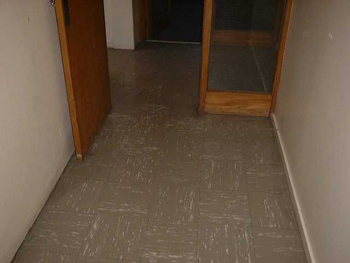Textured Ceilings
The term textured ceiling refers to the "porridge" like material that was a popular alternative to Gib stopping in the 60’s, 70’s, and 80’s. The product is also known by its popular trade names “Glamatex” or “Whisper”. Textured ceilings certainly represent the most common sample we are presented for analysis.
Appearance ranges from white to cream, many of which have glitter or metal flakes added. All types applied prior to the mid 1980’s may contain asbestos regardless of appearance. Chrysotile (white) asbestos was added to the product as a binder, although not exclusively.
Even some of the earlier textured ceilings had an organic fibre binder and no asbestos content. This substitution of asbestos with organic fibres became more common in latter years before asbestos in textured ceilings was eventually phased out entirely.

Textured ceilings generally represent a low level of risk when compared with other forms of asbestos, although the public perception does not always reflect this.
Misconception 1: Public often believe that textured ceilings are pure asbestos.
They in fact only contain a relatively small percentage of what is the least “problematic” of the three main asbestos types. In general the original applicators of this material incorporated somewhere between 1 - 5% Chrysotile if this material was included.
Misconception 2: The house I’m living in has a textured ceiling which may contain asbestos, it has to be removed
US - EPA ‘Removal is often not a building owner’s best course of action to reduce asbestos exposure. In fact, an improper removal can create a dangerous situation where none previously existed.’
a) If the material is still sound and the likelihood of asbestos fibre being released is low, then there is no legal requirement for its removal!
b) If however the material is ‘flaking’, (small deposits continually being found on the floor or furniture), then the risk off Asbestos Fibre going airborne increases as subsequent foot traffic or direct manipulation of the material by children or others is likely to occur. Under these circumstances we believe it to be an appropriate time for the material to be at least stabilised (sprayed with PVA/paint), or preferably removed.
While many people do concern themselves about the potential health risks regarding textured ceilings there are just as many who no longer appreciate this coating and wish it removed for aesthetic reasons or are looking forward to renovating the areas concerned.
For both of these scenarios the material will need to be analysed initially to determine if the material contains asbestos.
If the material is found to be positive and the householder opts for removal, we highly recommend the use of an experienced professional to perform this function. Should the householder insist on removing this himself then we recommend that he/she first obtains a copy of ‘Removing Asbestos from the Home’ a document produced by the Department of Health (Ministry of Health, Code 7022), which outlines this procedure in detail .
A highly abbreviated summary follows:
- Respiratory protection must be worn, preferably a P2 or P3 grade half mask.
- The material should be scraped wet.
- A comprehensive drop sheet, preferably thick gauge plastic that can be taped to walls needs to be used to protect any carpets and soft furnishings from contamination.
- The bagged asbestos waste needs to be disposed of through an approved asbestos contractor or waste management company.
- We recommend conducting background asbestos air tests after the material has been stripped.











